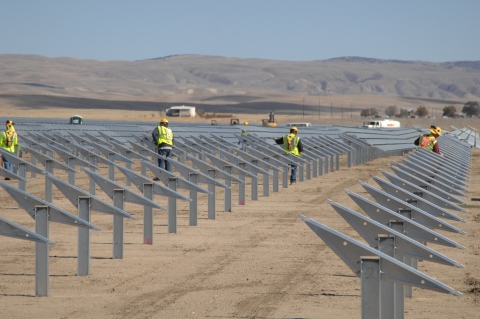In keeping with the environmental benefits inherent with solar energy, the solar industry in Alabama has an opportunity to consider conservation awareness and potential impacts when planning projects. The best steps to conserve species and sensitive habitats are to avoid species all together; however, when avoidance is not practical, there are some voluntary measures that can be implemented. The U.S.Fish and Wildlife Service (USFWS) Alabama Field Office offers the following recommendations for conserving federally protected and other at-risk species and is intended to guide resource managers and others during the construction and operation of solar farms in the state:
Voluntary Best Management
- Avoid sites with species or habitats of concern where possible.
- How? By conducting an online assessment with IPaC. IPaC IPaC
Information for Planning and Consultation (IPaC) is a project planning tool that streamlines the USFWS environmental review process
Learn more about IPaC generates a report describing species that may be present in the proposed project area. The IPaC report provides the foundation to work with the USFWS Field Office to develop/enhance native landscapes and reduce loss of habitat. - Possible methods for minimizing impacts to listed species:
- Consider conventional agricultural activities that can be performed beneath/around solar arrays;
- Maintain or establish a minimum 50-ft undisturbed native forested buffer along intermittent streams and ephemeral wetlands and 100-ft wide buffers along perennial streams and wetlands;
- Conduct risk assessments to determine threats that identify areas and issues of concern;
- Consult with natural resource agencies for up-to-date deterrent and mitigation measures to protect species and habitats that could be negatively impacted by solar projects;
4)For enhancement and other protective measures, please see below;
Migratory Bird Enhancement Measures
- Develop an Avian Protection Plan (APP). An APP is a utility-specific document that delineates a program designed to reduce the operational and avian risks that result from avian interactions with electrical facilities. A utility that creates an APP can benefit through regulatory compliance, reliability improvements, costs savings and positive recognition from regulators and customers;
- Avoid siting lines in areas where birds concentrate, when possible;
- Bury or install collector lines below PV panels/insulate wires to cover exposed connections;
- Use markers or reflectors on wires and powerlines that cannot be buried;
- Bury or co-locate generation tie lines with existing infrastructure;
- Limit the length of new generation tie lines to two miles or less;
- Powerlines should be constructed using avian-safe pole designs;
- Self-supporting towers, which do not require stay wires, are preferred;
- Utilize deterrent technologies to deter birds (i.e., bio-acoustic or decoys);
- Vegetation management should be conducted outside of nesting season;
- To minimize impacts to birds during nocturnal activities, lights should be installed such that lamps and reflectors have cut-off shields and use down-lighting to avoid illuminating the nighttime sky;
- Implement year-round bird-strike and attraction monitoring/surveying;
Terrestrial Species
- Implement and maintain best management practices for erosion control prior to any land clearing or construction and for the duration of the proposed project using alternative, natural fiber erosion mesh or matting rather than plastic monofilament that can entangle snakes and other wildlife;
- Elevate solar panels so they are at least 2-3’ above the ground;
- Protect and maintain diverse, native herbaceous groundcover that is drought tolerant wherever possible;
- Use wildflower/native warm-season grass mix to provide wildlife habitat and benefit pollinators in order to minimize maintenance;
- If within the range of the gopher tortoise--A complete gopher tortoise burrow survey should be conducted at the site. Additionally, any vegetation management should be conducted outside of nesting season;
- If a gopher tortoise is killed or injured, whether intentional or accidental--report to USFWS.
- If a gopher tortoise burrow is discovered in or around the project after completion--report to the USFWS;
- Establish a no kill snake policy in locations where T&E snake species may be present;
- If within 0.5 mi of bat hibernacula in Priority 3 or 4 locations or within 1 mile in a Priority 1 or 2 locations, further evaluation of impacts in the project area should be considered;
Aquatic Species
- Wetland and riparian riparian
Definition of riparian habitat or riparian areas.
Learn more about riparian areas should be protected with a minimum 50-foot upland buffer; - Plan for stormwater management and impacts to local watersheds;
- If pesticides or chemicals will be used for site maintenance, then stormwater runoff from the site should be directed to bio-retention areas prior to discharge;
- Direct stormwater runoff to bio-retention areas prior to discharge into streams or wetlands;
- If impacts are unavoidable to wetlands or streams, consult with the U.S. Army Corps of Engineers (USACE) to determine if jurisdictional waterbodies are present and if a permit and mitigation is required for activities impacting these areas;

